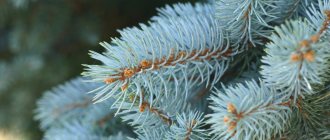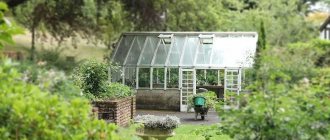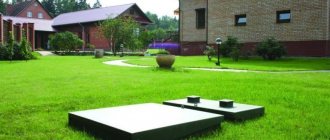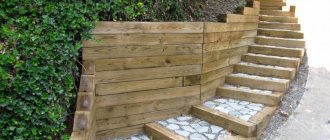Every gardener probably dreams of starting something like this on his six hundred square meters! The main thing is that it grows for a long time, decades, and all these years it brings joy with its amazing appearance. What is this? Of course, spruce! We will talk about how to plant a spruce on a site and what care to provide a young tree after planting in the article.
How to choose a seedling of a coniferous plant 2. Timing of planting a spruce on a plot 3. Where to plant a beautiful spruce 4. Preparing a planting hole for a young plant 5. How to plant a seedling in the garden 6. How to properly care for a tree
Photo by ru.depositphotos: If planted correctly, the spruce will delight you for many years.
These beauties, bright representatives of conifers in areas near houses, are not such a common occurrence. Why? Some are simply afraid that the spruce, when it becomes an adult, will shade most of the site, while others believe in superstitions that this tree on the territory is not good. However, most people still do not believe rumors and nonsense and, having planted a spruce on the site, they are only glad that they did it: they admire and enjoy the aroma that comes from the tree all year round.
Landing for the watchman
Cultivation of the chapel is a complex process, all stages of which are closely interconnected.
The most critical and reliable is harvesting. Therefore, the planting of the watch and the technology of growth are planned in accordance with the chosen method of the future harvest. Planting method
If you plan to harvest the crop using special equipment, then it is correct to trust the machines to plant the planting plant, since only mechanization allows you to guarantee the parallelism of the rows, the uniformity of planting depth and distance with roslinami.
Obviously, the most favorable conditions for growth are created when the cloves are spread down to the bottom. Besides statistics, with a mechanized planting method, approximately one-fifth of the teeth can move along the vertical axis. However, the yield varies slightly, in the range of 10-12%.
Geometry of beds
The optimal layout of the field needs to be planned based on technology, which obviously requires adherence to the following rules:
- The minimum distance between rows is no less than 25 cm
- The interval between the plants in the row requires 8-12 cm, depending on the characteristics of the variety and the average size of the one-tooth / clove
- If, for whatever reason, the space between the rows still needs to be less than 25cm, then it is proportionally necessary to increase the interval between the plants in the row
- The heavier the tractor wheels, it is easier to maneuver between the rows and more plants can be planted per area
We recommend, when growing without watering, the technology of planting a 45cm + 45cm clock on narrow wheels:
І scheme with drip irrigation 45cm + 30cm on narrow wheels:
The required quantity of material for planting per 1 hectare of area per hour (in kg), can be calculated using our calculator , or according to the table of A. A. Bogatirenko:
Planting depth
The key parameter that affects savings and productivity is also the depth of planting. They are chosen based on a complex of natural factors, the characteristics of the seed material and the planting time of the plant.
- Climatic zone . When planting in the spring, choose a depth of 6-12 cm. To protect the plant from freezing, the temperature of the soil at the level of the placement of the cloves should not fall below -9°C. It is important to consider the winter hardiness of the variety. Spring planting can be done in shallower depths.
- Soil characteristics . The type of soil determines its ability to protect the soil from the cold and dampen moisture.
- Clay soil has low hygroscopicity and heat loss, so it is recommended that the planting depth of the winter plant (from the bottom of the plant) be 6-7 cm.
- Light soil , lack of soil formation requires planting of large-sized soil material at a depth of 9-10 cm.
- Black soil is characterized by a light mechanical structure, which ensures good aeration and resistance to temperature changes. This specialness is even more valuable if you plant the watch for the winter. For such soil, the optimal planting depth is 6-7 cm.
- Caliber of planting material . The technology for planting spring orchards, as well as winter ones, is strictly dependent on the crop variety and medium-sized monotooth. The depth for winter varieties, growing at the bottom, should be from 5-6 cm for small cloves to 8-10 cm for large ones. The planting conditions for the spring plant do not transfer negative temperatures to too much of the middle, so the ground material is planted so that the top of the cloves extends no more than 2 cm above the level of the ground.
Planting calendar
The optimal time for hanging is in the area. Farmers are confident that when they plant an hour, they respect the local climatic features. People don’t pay much attention to the weather - cold autumn and warm days can quickly give way to the first frosts, after which it will be too late to set the clock.
According to the rules of commercial development of the winter season in Ukraine, planting terms are selected depending on the region:
- in sunset and sunshine areas there are favorable days for planting in the remaining ten days of the year;
- in the central regions - in the third decade of spring, it is allowed to plant winter crops in the fall, in the first days;
- in summer and early days - in the middle decade of spring.
The term is selected in such a way that before the start of winter the shoots have formed a root system and are thoroughly rooted, possibly growing up to 2 cm and sprouting 1-2 leaves. The optimal time for planting a winter plant is when the temperature in the upper soil reaches 10-12 ° C.
In the spring, the root system begins to develop at a temperature of 1-3 degrees below zero. Steam appears when the soil warms up to plus 3-5°C. Cibulin is formed at 15-20°C, and ripens at 20-25°C.
Winter-hardy varieties can withstand frosts down to -25°C. The best advice for such plant material is that if you plant a winter plant, it is necessary to give the cloves the opportunity to take root before the first frost. Now, even after the first sunny days of spring, new flocks appear. Poorly rooted plants have a tendency to freeze even at -10 ° C. Therefore, for winter varieties, the earliest time of planting should be 3-4 hours before regular frosts begin in this climatic zone.
The cold doesn't matter
Garlic is a very cold-resistant crop: winter varieties can withstand frosts of 20-25 degrees.
But, despite this, the cloves should have the opportunity to take root before frost. Poorly rooted plants usually freeze out already at minus 10 degrees. The timing of planting garlic directly depends on the weather, which is very changeable in the fall. Warm days may suddenly give way to the first frost, after which it will be too late to plant it.
Therefore, the planting time is selected in such a way that by the beginning of winter the plant has time to form roots and take root firmly. Better yet, grow a couple of centimeters and produce one or two leaves.
The optimal moment for planting winter garlic is when the temperature in the upper five-centimeter layer of soil is not lower than plus 12-14 degrees. In time, this is usually the second ten days of October. There are still about three weeks before the cold weather, and during this time the garlic will have time to take root.
Since it is not afraid of the cold, in early spring its root system will start working and begin to develop at minus 1-3 degrees. Sprouts will appear when the soil warms up to plus 3-5. The bulb is formed at plus 15-20, and the head itself ripens at plus 20-25 degrees.
The growing season for winter non-shooting varieties of garlic is 75-90 days, and for those that go into the shoot - 110-120.
How to properly plant a chapel so that you become great
Who doesn’t love such a fragrant and savory spice as chasnik? This vegetable is often harvested in our region for the preparation of various herbs. If you have a summer cottage, you can independently grow the winter season, which will grow to great proportions. Therefore, planting begins approximately a few days before the first frost, so that the plant does not freeze and produces a wonderful harvest in the coming season. How to plant a chapel before winter (video) and make it great? The evidence on this topic will be discussed in this article.
How to plant a chapel before winter?
Watering rules
Garlic is very demanding of moisture, especially at the time of sprouting and bulb growth. And all because it has a poorly developed root system and a very low absorption capacity of the root itself, which is located in the upper (most dry) layer of soil. Pay attention to table No. 2.
The water temperature should not be lower than plus 16-18. The best time for watering is morning and evening. But if the average daily air temperature is below plus 15 degrees, the garlic is not watered.
From the emergence of seedlings to the beginning of the formation of bulbs, the soil should be wetted to a depth of 15-20 cm, and during the formation of bulbs and until the end of the growing season - by 20-25 cm. Three weeks before harvesting, all watering stops altogether.
When we give water, we fill the soil capillaries with moisture, and because of this, oxygen circulates poorly. Plus, a soil crust is formed, which, again, inhibits the flow of air and nitrogen to the roots. Therefore, it is so important to loosen the soil after each watering.
How to plant a chapel before winter - for practical reasons
Chasnik is not a flexible crop that can grow on any kind of soil, but in order to get a bright, healthy harvest, it is recommended to create the most favorable conditions for planting. Yaki?
- Miscenahodzhennya. You don’t love a chasnik if you sit him too quickly on one and the same place. It is important to periodically change the location of growing crops, rather than planting them after such plants as cibula, tomatoes, peppers and eggplants. These vegetables are infected with fusarium, which often infects the head of the plant. If you plant it after watermelon, cabbage or legumes, you will not only save it from unpleasant diseases, but also create a friendly mind for full growth.
- Dobrivo. Do you want to bring food for the winter season? Before planting, it is not recommended to fertilize the soil with mineral or organic fertilizers; sprouts react positively to neutral, non-acidic soil, and additional fertilization often oxidizes the soil. In the dobrova pit, you can vikorize peat, which is a trace of digging from the soil.
- Sleepy light. Immediately after planting, an important step is the rooting of the crop, which will reveal a sufficient amount of ultraviolet light. It’s not good for him to plant a chapel in the shade or under a sloping tree. Try to find out the place on the rise.
How to plant a clock before winter so that there is great growth? For whom is there a bunch of secrets? First, thoroughly soak the heads of the chasnik in a weak solution of potassium permanganate. This protects the plant from infection and attacks by various infections. You can also use a strong dose of kitchen salt. A healthy culture means great fruits. Otherwise, it is necessary to remove the “maternal” baby, which most often inhibits growth.
Who's behind whom?
Garlic loves highly fertile sandy, sandy loam or light loamy soils.
Since the plant is slow to emerge and develop slowly, weeds are a serious problem for it. It is better to allocate a higher area for garlic: in the lowlands it rots and gets wet, the bulbs and cloves become smaller, and the bottom falls apart.
Despite the fact that this vigorous vegetable loves fertile soil, it reacts poorly to pure organic matter. Therefore, we apply fresh manure not under it, but under its predecessor. It’s good if it’s legumes and pumpkin crops, early grains and cabbage. Or black steam.
But after potatoes, onions and tomatoes, garlic grows very poorly, which has been experimentally proven more than once. The root secretions of these crops inhibit its growth and development. This vigorous vegetable can be returned to its original place no earlier than after four years.
Rules for planting winter grass for the winter in Ukraine
It is better to hang the watch on a small distance one after another (approximately 10-15 cm). It is also important to maintain a distance between the rows - about 30 cm. It is important to allow the plants to grow in their full growth.
Before the time of planting, do not press too hard on the planting material, trying to root it in the ground. You need to make a small hole and place a clove there. Apply earth to the top.
Important! The deeds of the Fahivtsi are glad to plant the clock on the great depth. This advice is only relevant in the season when you are late with planting and there are only a few days left before frost. Deep planting protects the plant from frost and cold.
How to properly plant a chapel in autumn?
Before planting time, do not forget to lightly water the soil, if the stone is too dry. Afterwards, you need to sprinkle the bed with a small amount of peat and compact it thoroughly. There is no need to water further.
Well, now you know how to plant the clock for the winter (video) and it will be great. We hope that it is our pleasure to help you grow a rich, juicy and savory winter harvest at your dacha.
Video: When you plant a clock for the winter, it will be good for you
We recommend that you take a look at the City of Vie section; you can read a lot of articles about developing and looking after your city. Good luck to you, our dear readers!
When can you plant a spruce in different regions of Russia?
Planting a coniferous tree on a plot can be done both in spring and in autumn - there is no difference. However, many gardeners insist: spruce seedlings must be planted on the site in the spring. They advise choosing a period for planting spruce on a site in the spring so that sap flow in the plant and vegetation have not yet begun. However, when choosing early spring for planting, still try to place the spruce at a time when the soil in the area has already thawed.
This period can vary greatly depending on the region:
| Region of residence | Timing for planting coniferous plants |
| Southern regions | You can plant a spruce at the end of February. |
| Central regions | This is usually March or April. |
| Northern regions | Late April or early May - depending on whether spring is early or late in the current season. |
These are the rules, but there are exceptions, that is, it is possible to plant spruce in open ground at any time of the year. Some gardeners believe that planting any seedling with a closed root system, including spruce, can be done in spring, summer, autumn and even winter. Of course, planting in summer and winter has its risks:
- When planting in the summer, needles must be shaded from the sun's rays for at least a week, and the plant must also be watered frequently. After all, it’s hot outside and the soil is dry.
- When planting in winter, there is always a risk of roots freezing. Therefore, think for yourself whether it is worth the risk, or whether it is better to plant a spruce in the fall (in October or early November) or in the spring (in March or April) - during the most suitable periods for this.
Winter planting lines
It's not too late . The planting lines for the clock vary from midsummer to the end of leaf fall. It is important to plant the clock 40-50 days before the onset of cold weather. The exact landing time depends on the weather forecast and climate of the region in which you live. The meaning of the terms cannot be dogma, even though we work on the ground with the growths and old signs that our grandfathers and ancestors used to grow. Whereas in the past it usually snowed on Pokrova, now it’s unlikely to do so. Therefore, watch out for nature, it will show you when and what you need to plant.
We are preparing beds for planting for the winter season
Be sure to make sure that you make changes to your business, as long as you are small. It is necessary to plant the clock in the right place no earlier than after 4 days. Colorful vegetables: beans, watermelons, cucumbers, zucchini, early cabbage. The chasnik is even more vigilant to the ground. You need structured native soil, preferably light loam with a neutral reaction. The beds are prepared in advance, as they emerge from summer crops, adding 3-4 buckets of humus to the beds or composting the soil. When the plot is leveled, since the soil is susceptible to acidification, you can add dolomite hogwood, or hydrated water, since the gardener does not like acidified soil, and with a slight increase in acidity, the gardener feels depressed.
To grow the clock, it is not suitable for dry orchards, mulled grains, or dry soil. It is important to be mindful - control the acidity of the soil and add deoxidizers every 4 days.
Since there is no need to reduce it, it means adding a complex mineral fertilizer according to the instructions, sprinkling the animal with wood ash, in a small amount. Why is ash needed? Because it acidifies the soil very minerally, ash is a natural deoxidizing agent, but not very strong. After this, dig up the bed using a shovel or a little bit less, leveling it with a rake. As soon as the soil settles, the bed is ready.
Tricks of planting a clock for the winter
Before planting, during the week, we prepare the teeth for the watchmaker. We place the heads, look at them, with defects and put them on the side for planting; they will not fit. We choose only large cloves for planting if you want to remove the large heads of the clock and the barrel. The inner teeth are also not suitable for planting. We examine the bottom teeth, if they need to be cleaned, we clean them to reduce the development of the roots. Place the prepared cloves in a polyethylene cup, cover with newspaper or paper, leave for a day or two on the veranda. During this hour, the cloves will begin to develop tiny crusts. Once again before planting, we look at the garlic. If defects are found that were not noticeable before, they will be rejected. For planting, use a shovel holder with a diameter of 3-4 cm. At the end of the stick, which enters the ground, you need to drive a nail at a distance of 10 cm. The nail will be cut to sink the end of the stick into the ground. Using a hammer, make holes with a distance of 10 cm, between the rows 20 -25 cm. When planting, press the teeth into the planter without leaving a trace, which can complicate the development of roots. If the soil is dry, the holes need to be shed a little with water and potassium permanganate. The holes can be composted with soil. We mulch the entire bed with peat (for fear of freezing, mulch the bed with mature thyrsa or sprinkle with yalin gills), but in the middle smoothie there is no work to be done. Add more snow to the bed with more paths.
Spring troubles
In early spring, a bed for snow-tanning can be sprinkled with ash or covered with black sap. As soon as the snow stops and the temperature reaches above-zero temperatures, the bed needs to be loosened so that the greenery can quickly come into being. The feather has grown by 10 cm, we need to feed it with chaff (1 tablespoon per 10 liters of water). As a legacy, the annual chasnik is filled with green goodness. When yellow ends appear on the soil, it is necessary to fertilize the plantings with potassium sulfate (per 10 liters - 2 tablespoons). Water a chasnik 0.5 l under the tree.
We change the arrows to the clock
The arrows will bend if they reach a height of 5-10 cm; with a higher height of the arrows, the growth will take away the excess of living parts, which is indicated on the size of the head of the clock. To control the ripening flowers, I remove a few sprouts along the arrows (one in the middle and one at the edges of the beds). As soon as the bulbs on the heads of all three arrows begin to crack, it’s time to dig out the clock. I’m watching a watch on a dry, sleepy day. I dig with a pitchfork and shake the watch. I put it on the bed to dry. In the evening, I put the dried garlic in a room to dry, where it continues to dry for 3-4 days. After this, I trim the feather, removing 8-10 cm of stump. Before taking it home, I remove the stumps and put them in small boxes. I select the largest one for planting, tie it in bunches, and let it dry until planting. I agree with my article about the terms of planting a winter chapel and the methods of planting a chapel for the winter, you will have a bark, and you will be able to grow a great, beautiful chapel.
Subscribe to the latest blog and be the first to read the articles. Until new zustrich!
We're about to land
Since the root system of garlic is sensitive to the density of the soil, one to two weeks before planting we loosen the soil deeply (25-30 cm).
In a dense plant, the roots will take a very long time to grow - the bulb simply will not develop. In the end, goodbye to the harvest. Immediately before sowing, we once again cultivate the area to a depth of 10-12 cm. It is very important that the soil is finely lumpy and not crushed into dust. If necessary, we add fertilizers, humus and compost. But not fresh organic matter. It only accelerates the growth of leaves and shoots, increases the risk of infection with fungal diseases, and also reduces the volume of the bulbs, reducing their shelf life. It is best to plant garlic on high ridges so that the roots have room to grow. Which teeth to choose: large or small? Well, of course, bigger! They form more roots. And since it is the roots that deliver all the necessary nutrients to the plant, the harvest will be more significant.
Before sowing, be sure to check the seeds for contamination with pests and pathogens. The stem nematode is especially dangerous. It is transmitted mainly with planting material and, under favorable conditions, can completely destroy the crop.
The nematode survives in the storage area and infects nearby bulbs. The garlic affected by it has a rotten, soaked bottom that seems to be pulled inward.
Having discovered a nematode, warm the planting material in hot (plus 45-50 degrees) water for 40-60 minutes. At this temperature, all stages of the soil worm will die. You can do it differently. Soak the garlic in hot water for ten minutes, and then wrap it tightly in plastic wrap and cover it with a blanket for an hour so that the bulb warms up properly. Such a font, by the way, will speed up germination.
To avoid nematodes, you should not plant garlic after barley and wheat, which are kind of hosts and reserves for these soil pests.
Garlic must be planted with its bottom in the furrow, and not upside down. The fact is that its bulbs are strictly oriented in space. If they lie in the furrow with the bottom up, they germinate poorly and take a long time. The arrow also moves to the side: it always clearly grows in the direction where the top of the clove points.
The key parameter that affects both the yield of garlic and its preservation is the planting depth. We measure it from the bottom of the onion, focusing on a complex of natural factors. Usually this is 6-12 cm. To prevent the cloves from freezing, the soil temperature at the level of their planting should not fall below minus 9 degrees in winter.
Much depends on the type of soil. Clay soils have low hygroscopicity. They do not retain heat well, so the planting depth of winter garlic should be 6-7 cm. If the soil is light and sandy loam, then 9-10 cm is needed. Chernozem is usually well aerated and perfectly protects against temperature changes. Here the optimal planting depth is 6-7 cm.
Viroschuvannya to the watchmaker.
Leather in the market costs more and more - 7-9 times more expensive than potatoes! And three times more expensive than the sun in the middle of the season. The main reason for such road conditions is the frequent freezing of last winter and weather disasters.
But the proven mayor is obligated to give the gift of transfer in order to avoid such a situation. It is worthwhile to read the literature about the correct development of the clock, so that the future can avoid expenses. So, what do the city workers recommend?
Let's talk about the high frost resistance of the winter season. You can hear the songs of frost in good weather, but not the kind we had last winter. Another reason for the clock plant to freeze is early planting in warm soil, when it comes before frost to release the plants from the ground.
The third and third landing of the clock. Yes, and planting at a greater depth, in the spring there will be more growth, while still growing and yielding a harvest! The winter chapel grows sadly on the sunica plantation. Do not harvest before the leaves fall. First of all, pour the mixed ashes, selected egg peel, cybulin husk and humus onto the garden bed. Take teeth only from large, healthy, well-dried heads.
Tooth or bulb?
Garlic reproduces only vegetatively: clove, air and single clove. Each planting material has its own characteristics. Pay attention to table No. 1.
Most often, cloves are used for planting.
But when propagated by aerial bulbs, it is possible to renew and improve the health of the seed. After all, the bulbs do not come into contact with the soil, where the pathogens are located. True, we will get a real multi-toothed bulb only in the second year. In the first one, a small one-toothed one is formed, which is often called a set. One-toothed set is an ideal planting material, free from diseases and pests. It takes root better and overwinters, producing a harvest the next year. His bulb is always larger. And there is no need to separate them when planting.
Over two years, garlic goes through three stages: bulb - garlic set - normal bulb.
You can get a good head in one season. Cloves planted before winter will produce a full harvest next year. But garlic grown in this way, due to its biological characteristics, will begin to degenerate and lose its genetic potential in three to four years. Productivity drops sharply, the size and weight of the cloves become smaller, growth vigor decreases, taste deteriorates, immunity decreases, diseases and pests easily attach.
Winter chapel, winter hut.
In the spring, do not fertilize the bed with a chameleon, because the sun will be growing all summer, and between each spring the chameleon will appear. The teeth fade by 6-8 cm, the bulbs are smaller up to 3 cm. In early spring, give it time to add additional mineral goodness and compost, then after the leaf growth it becomes clear that the plant does not grow. If their ends are pale green, then prepare them with chives; red and wither - superphosphate; become corrugated - potassium magnesium.
Most of us, having grown up, dug up the sprouts, deprive them of the soil in the garden for 3-4 days. You only need to save the hour in the shade under a canopy. At the end of the day, the clock quickly spends its entire life, and at night it is filled with dew, and as a result, it is poorly preserved. It would be better for him to be tied up in small braids and sent to a dark barn. After a month, trim dry roots, stems and heads into a fabric bag.
To grow the clock, add a trace to the edge of the bed, the fragments of the wine will contain a lot of living waters. It grows on thick cucumber beds, richly fertilized with humus and chicken residue last fall. The infusion of stench must also be prepared regularly by drinking organic infusion. Therefore, in the spring, after they are harvested, the beds will always be tall and fluffy. Another detail: to ensure healthy planting material in the future, remove the one-toothed flowers from the flower stalks. Do not bother with digging up the heads, the little spots in the middle of the linden tree begin to yellow the leaves.
In the spring, after planting the chapel, the bed is covered with scorched leaves, and so that the wind does not blow them, crush dry cut raspberries. In the spring, after harvesting, the beds are always wet and clean, without weeds.
It is noted that the hour is most effective after potatoes, when the sickle cob is harvested. After digging, do not break the piles of earth, do not fill up the holes: in this manner, in the heat of the sun, all the spoils that were lost in the soil after the potatoes will die.
Between the large rows of potatoes, grow new ones, water them generously with water, fertilize them with rare infusion of bird droppings, and hang radishes or radishes. After the radishes are harvested, the beds are watered, lightly fluffed up, and a flowering plant appears in the fall of leaves. In a birch tree, when its feather moves 10 cm, fluff the bed for the first time, sprinkle with ash and water. Dig the clock early, so that the sun does not bake the fresh heads, immediately tie them up and grow in the dense crowns of trees. During the winter, the watch is stored in small boxes in the shade - it is cool and dry there.
Fans of vigorous
The most dangerous disease of garlic is fusarium.
It is this that reduces germination. To detect it, you need to trim the bottom before choosing heads for sowing. If it is white, then there is no disease. It is worth paying attention to the color of the teeth. Redness is a sign of fusarium. Ticks also cause a lot of trouble. But they never develop in a healthy bulb. If it is even a little damaged, then they are right there. The pest penetrates the head, turning it into dust.
Thrips also cause significant damage, sucking the juice from the plant and significantly reducing the yield. Only chemical treatment can save you from them. Oddly enough, drip irrigation provokes their growth, and sprinkling, on the contrary, actively fights them.
Aphids are also not uncommon on garlic. Typically, pests gather in the stalks of leaves and near the inflorescence itself. Not only do they gnaw plants, but they also transmit viral diseases.
Landing for the watchman.
Pay attention to the importance of selecting varieties: plant only regionalized varieties. Dutch, American, Kuban varieties, steppe and forest species have been tested for more than 20 years, but there is no competition with local varieties of stench.
Otradnensky stands out the most. True, this variety shoots and it’s important to lift the arrows every now and then. Before planting in the grooves, sprinkle 5 cloves of sol, a tablespoon of superphosphate and a decimala of table salt. Cover the plantings with peat compost for the winter.
The chasnik grows taller in wide beds: at least 150-160 cm. In narrow beds it grows smaller and freezes. Three varieties include the Gribovsky Yuviley variety. The wine is spicy, and the spicy variety is better preserved. The beds are prepared over the summer: they dig up well, weeds are picked out, they are fertilized.
Then they dig across 25-30 cm wide and deep trenches and cover the skin with fine straw mixed with superphosphate: on the skin 2 kg of straw and two tablespoons of superphosphate.
The soil is well-watered, and the straw begins to thicken. Before the time of planting, the bed settles by 10 cm. In deciduous wild beetles, the outer teeth of the large heads are planted in trenches to a depth of 15 cm. Then the bed is leveled and covered with cut currant, agrus and raspberry stems to tame the sleep Igu. In early spring, when the leaves of the chapel grow 6-8 cm, water the bed with a rosemary spray of potassium permanganate (a bottle on the skin growth). At a height of 15 cm, prepare with ammonium nitrate: a box of blueberry in a bucket of water.
By nature, a skin gardener is an experimenter. And I love to feel many different varieties, choosing as a result the most beautiful ones. Today, a low, splendid, non-striking winter plant, which survives the winter without shelter, has “registered” in the farmsteads.
In addition, it ripens two years earlier than the main varieties and is carefully preserved: the heads do not dry out until summer! To my liking there is one fresh variety, full of taste, fruitful, and long-lasting. Garniy growing chasnik from Belarus, which gives great green heads in the future. In order to spend less, when planting, fill the bed with ash (a bucket for a thousand cloves) and two buckets of dry pigeon afterbirth. And in winter, the bed is mulched with fallen pine needles.
Porada: an hour of growing which should be done before hanging, vitrimate until the teeth are fresh in the form of potassium permanganate, which is good for non-infecting planting material from fungal diseases. Cream humus, sol and superphosphate, and add 40 g of potassium chloride per square meter to the bed. Favorite variety – Polit and Yuviley Gribovsky.
Arrows down
When growing winter varieties of garlic, it is very important to promptly remove the flower stalks, which absorb moisture and nutrients so necessary for the development of the bulbs.
It is necessary to cut the arrows in the “pig tail” phase, before they straighten and are still twisted into a ring. If everything is done on time, then a yield increase of 25-30 percent is guaranteed. And the quality of the heads will be noticeably better. Especially if small cloves were planted. The main thing is not to cut off the top leaves when removing the arrows. Once you have removed the flower stalks, do not leave them in the garden under any circumstances. Otherwise, aerial bulbs will form on them, which will sprout next year and litter the field with carrion.
How do you prepare a watch?
In the spring and summer, prepare for an hour: in early spring, infusion of pus - one kg per 10 liters of water with a tablespoon of beetroot added to the skin. Days - in the middle of summer - repeat a tablespoon of phosphate and calcium chloride soup.
Well, what are the truths behind all that has been said? So that the plant does not freeze, the rice is healthy and well preserved, then we should grow it in our minds: on the good cultivation of good gardens. It’s time to select the best variety, regionalized or already tried by you.
Only use healthy, good material. Plant in autumn leaves, during periods of severe cold and to sufficient depth. It’s important to keep it warm in the winter, without relying on “maybe”, and the rest: immediately pick up the watch, dry it properly and store it properly in a cool place.
Caring for spring garlic seedlings
As noted above, spring garlic needs more attention. In addition to mandatory watering before germination and 4 weeks after, it is necessary to fertilize. Spring garlic shoots respond well to nitrogen fertilizers and potassium chloride. Mineral fertilizer can be replaced with compost or mullein infusion.
The second feeding is carried out during the formation of the bulbs with complex fertilizers. To form a good harvest, plants need phosphorus and potassium.
Throughout the growing season, garlic beds must be loosened and freed from weeds. Watering in the second half of the growing season is carried out only during prolonged dry weather.
The spring form of garlic, as a rule, does not produce shoots, so the degree of maturity is determined only by the leaves. Harvesting can be done when the leaves turn yellow and begin to dry out. The bulbs are very painful to bear mechanical stress, bruises reduce their shelf life.
It is advisable not to pull them out of the soil, but to dig them up. Earthen clods should not be beaten off; it is better to carefully clean them with a glove. The selected bulbs are left in the garden for a while to dry. Then they are transferred under a canopy for ripening. After a few days, the stems are cut off at a distance of 5 cm from the bulb.
Properly harvested spring garlic is less capricious during storage and is successfully preserved until the next harvest.
Planting the clock before winter 2022: how and when
Author: Natalya Published at Gorodny Rosliny Published: 01 March 2022 Updated: 30 June 2019
Chasnik (lat. Allium sativum) is a rich herbaceous plant, a species of the genus Tsibulya from the homeland of Amarylisova pidrodina Tsibulevi. This vegetable culture has been popular among rich peoples of the world for six thousand years - a source of demand both in cooking and in medicine. The real ones are not only the plant stem, but also the leaves, shoots and flower stalks of young plants. The Fatherland grew up in Central Asia, and the chasnik was introduced into culture in the Georgian regions of Afghanistan, Iran, Pakistan, Uzbekistan, Turkmenistan and Tajikistan. For many years it was believed that the chasnik resembled a long-pointed tsibula, widened in the Girsky gorges of Turkmenistan and the Tien Shan, and further research confirmed this hypothesis - the chasnik is not genetically related It depends on what type of cybula it is, so with high probability it can be confirmed that the timekeeper is a variety tsybuli.
Grow it both in the spring and in the winter way. This article will tell you how to properly plant winter varieties.
At what distance to plant spruce trees: preparing planting holes wisely
After you have chosen the optimal area with loose and light soil, ideally loam, you can begin to prepare the planting hole:
- If you plant several spruce trees on the site, but it will not be a hedge, then you need to leave 5 meters between them. If you decide to create a hedge, then two meters will be enough.
- The dimensions of the planting hole are usually made based on the roots of the seedling. It is not necessary to dig large holes if the volume of the roots of your seedling is the size of a fist, and vice versa. Ideally, the largest hole for planting should be no more than one and a half times larger than the root ball. Let’s say the width of the coma is 50 centimeters, then 70–75 cm of the width of the hole will be enough. In the same way, you can calculate its depth.
- If the site has clay, heavy soil, plus groundwater close to the surface, then at the base of the pit it is necessary to make drainage from broken bricks or expanded clay. Its thickness is 20 centimeters.
When the hole for planting the spruce is ready, it is necessary to arrange a nutrient cushion for the root system at its bottom. It is best to make this nutritious pillow from a mixture of leaf and turf soil, peat and humus - all in equal parts. If you have little peat, then you can take one part of it, as well as river sand.
It’s great if you add fertilizer to the mixture: in the spring it’s a matchbox of nitroammophosphate, and in the fall it’s half a matchbox of potassium sulfate and superphosphate. It is important to mix the fertilizers well with the soil so that they do not come into contact with the roots under any circumstances. If you do not want to prepare the mixture, you can remove the top layer of soil ten centimeters thick and place it at the base of the hole, adding fertilizer.
Photo pixabay/photosforyou: Maintain distance between plants when planting.
Koli sajati chasnik before winter
Planting lines for spring 2019
Koli sajati winter hour? The winter season begins to grow in the fall. The first crop needs to be taken from the plot where you plan to sow the winter season, no later than the end of the lime tree. Planting of the plant on the ground begins 35-45 days before frost. Before winter sets in and the ground freezes, the plant grows to expand the root system of the plant by 10-12 cm, and the green foliage will no longer appear. The optimal landing time for the watchmaker is from 20 pm to the middle of the summer. However, if you wanted to grow the chasnik from the bulbs, and not from the teeth, then you can sit them in the kettle.
If a watchmaker is better than sadjati
If the plantings are too late, they will sprout, which cannot be allowed categorically, and if the plantings are too early, they will not take root and will freeze, so it is important to follow the correct guidelines for planting winter varieties.
Straw bed
Mulching is an important stage in growing winter garlic: moisture is saved and weeds do not grow.
It is best to mulch the bed with straw. Heating up during the day, it overheats, forming organic matter. And thanks to the temperature contrast (cold and warm air), moisture also accumulates in the root zone. In addition, mulching protects garlic from nematodes, which usually enter through the bottom. And since it is closed, the pest will no longer be able to get through.
The value of straw mulch is also that the stalk of garlic turns out to be tall (up to 15-20 cm) and white. This, by the way, is especially valued in Europe and Israel.
Planting winter chapel
After any culture, plant a chasnik
First of all, to choose a plot for the winter plant, you need to know when the plant can be planted, so that what crops can be transferred to the plant, and after which wines there will be no growth. The fastest-growing hour after similar vegetables with a short growing season:
It is not recommended to plant the planting plant on a plot where root crops grew - their crops should be harvested late, and it is unlikely that root crops will leave the soil. How can you sit the chasnik after the chasnik? Absolutely not. Same as after Cybula. The principle of fruition assumes that you can grow a clock on the spot, even in a flowing process, no earlier than three or four years later.
Watch before landing - preparation
In the fall of the hot bud, which reproduces only with teeth, the winter bud reproduces with both teeth and bulbs. In order to grow valuable cibulin from bulbs, you need two rocks, and from cloves you can remove large cibulin for the next crop after planting.
Before planting the spring plant, the seed material is sorted out, damaged teeth, damaged and ailing teeth, as well as those in which the membrane is damaged, then the acidic teeth are disinfected for 2 years using 400 g of ash. and two liters of water, which boils for a whole day and then there will be cooling. Instead of ash meadow for uninfected teeth, you can use a double sample of seeding material in salt solution (3 tablespoons per 5 liters of water) with further disinfection using a stretch of copper sulfate. sou (1 teaspoon per 10 liters of water).
Recommendations from the pros: sowing carrots before winter. Give birth much earlier!
Soil for a watchmaker
De sajati chasnik? The timekeeper is light-loving, therefore, grow under the sun in the soupy, non-acidic soil, digested for the previous crop - fresh rot in the soil for the timekeeper is brought to the point where it is more often affected by illnesses and diseases.
If it is necessary to add good soil to the soil after the previous crop, do so no later than a repeat or two before planting: dig up the soil with a shovel, adding 5-6 kg of humus per square meter, as well as 30 g superphosphate i 20 g of potassium salt, then pour a dose of copper sulfate (1 teaspoon per 10 liters of water). Before planting, cover the bed with spit.
How to plant a chapel before winter
In preparation for planting the plot, make furrows in the depths of 15-20 cm at a distance of 20-25 cm one at a time, pour coarse-grained sand into the bottom of the grooves with a 1.5-3 cm ball to prevent contact of the teeth with the soil and protect They look rotten. The distance between the large cloves is 12-15 cm, and between the small cloves – 8-10 cm. After laying the cloves in the soil, mulch the plot with a two-centimeter ball of dry peat or thyrsium mixed with soil.
If the winter is snowless, you will have to cover the sowing with roofing felt or polyethylene, unless it starts to snow, remove the melt so that the snow falls on the plot.
How to plant a spring tree - take note so as not to make jokes in the spring!
If you sow the bulbs in the seed container, hang them at a depth of no more than 3 cm at a distance of 2 cm, one at a time, with a distance between the grooves of 10 cm. If you sow the bulbs in the spring, kvitny, then until the fall the stink will be given by one-toothed cibulins, like It is necessary to dig it up, dry it and replant it in the soil, so that in the coming season the stink will produce a full supply of cibulin.
Watching the clock after planting in the spring
Landing and keeping an eye on the clock will not cause you any trouble. Winter garden is a culture with a high cold tolerance, and if only the trees have begun to grow the root system before winter, they will survive the winter well, especially if you mulch the plot and cover it with roofing felt. In the spring, remove the cover from the plots and clean off 2 cm of mulch to make it easier for the plants to get through the soil. Finally, the worm clock begins to remove the arrows, which must be removed before they reach a height of 10 cm, otherwise the cibulin will become too small as a result.
As soon as fresh greens appear, add nitrogen fertilizer to the soil - chaff, mullein or poultry afterbirth. When it’s ready to heal, add 200 g of ash to a cup of water and add it to the soil or linden. A chasnik is best served with organic goodness. Watering the plant in the phase of active growth should be done in the early stages, in the phase of ripening cibulin, switch to dead watering, and if the weather is rainy, then the need for additional fermentation falls, leaving excess water in the other half of the growing season. Iodine provokes illnesses and depletion of cibulin.
After watering, I’ll make sure the soil is cleared away, and the storms appear. As soon as you hatched, you mulched the plot, fighting the weeds, fluffing the soil and watering the clock you will have to do much less often.
It is necessary to harvest the chasnik in sleepy weather, when the lower leaves are heavily harvested - there will be, for example, a sticky residue, or on the ear of the sickle, two years earlier, the lower ripening chasnik. Dry the leaves of the winter herb in the sun for 4-5 days, clean the soil, trim the stems and shorten the stem to 10-20 cm.
Menu on request
Garlic reacts very sensitively to fertilizers - it loves to eat.
To form 1 ton of bulb yield, 7.96 kg of a.m. is taken out. nitrogen, 3.43 kg a.i. phosphorus and 4.06 kg a.i. potassium Therefore, a high yield is possible only with the complex application of humus or compost (40-50 t/ha) and mineral fertilizers at the rate of NPK - 60-80-80 under the predecessor. The average yield of winter garlic is around 8 t/ha (or 80 kg per acre). Although with intensive cultivation of some productive varieties (Lyubashi, for example), it is possible to harvest 120 kg per hundred square meters.
From the moment the first shoots emerge until the bulb begins to form, we apply a mixture of nitrogen and phosphorus fertilizers - 1: 1.5-2. We use “Nitroammofoska” for re-feeding after half a month: potassium will be needed.
Phosphorus-potassium fertilizers can be applied throughout the growing season. Phosphorus is necessary for the full development of the aerial part, successful weight gain, ripening of the head and saturation of the cloves with microelements. We use phosphorus solutions both for foliar feeding of garlic and when the leaves begin to turn yellow or fade prematurely.
The general rate of mineral fertilizers for garlic is calculated in the proportion NPK - 120-100-100. Therefore, on sandy loam soils in the fall, before fall plowing, we add 400 kg of humus and 1.5 kg of “Superphosphate” per one hundred square meters.
15-20 days after the appearance of the first shoots, we give a full complex of mineral fertilizers to the roots according to the formula NPK - 120-60-90.
Garlic also needs sulfur-containing fertilizers (“Potassium sulfate,” for example), especially during bulb growth. Magnesium, zinc, boron, and manganese are also important.
With this feeding scheme, you can safely count on a good harvest, the estimated yield of which is 1:13. That is, by planting 1 kg of cloves or bulbs, it is quite possible to harvest 13 kg of garlic.
Peculiarities of planting winter grass
Planting a chapel before winter in the Moscow region
As a matter of fact, there is no great difference between the development of the winter season in Ukraine and in the Moscow region - everything will lie down until winter arrives. If winter begins with snowfall, then you probably won’t have the chance to cover the clock with spitting water, otherwise, in case of severe frosts, the winter will be snowless, and without covering the clock, it will be freezing. Above all, do not let the crops freeze in the ground, so focus on the amount of snow: a lot of snow - do not turn the clock on, a little - turn it on. In the spring, if you come and go, all your fears will be put behind you.
Planting a chapel before winter in the Urals
Ural city workers recommend not mulching winter plantings, but simply covering them with roofing felt or spitting material against frost. Mulch the plot better in the spring, when it hatches. In addition, since over time, the chapel becomes more granular and preserves thicker, the Urals recommend that the planting material be grown not from teeth, but from bulbs: in the first river, bulbs will produce one-toothed cibulins of medium size, then the next day the stench will become noticeably larger.
It is not recommended to fluff the soil in the Urals; when fluffed, the fragments are crushed by the top row of roots, and the growth may fail to remove any element of the food, become weaker and, possibly, cause illness. The spring plot is mulched, removing fluff is an unnecessary procedure and preserves the health of the growth.
Planting a chapel before winter in Siberia
In Western Siberia, the planting time for winter crops is very early - from the middle of spring to the first week of autumn. In addition, the plots with crops are covered with roofing felt until the snow falls. Otherwise, planting and monitoring the clock differs little from these processes in other areas.
We purchase and prepare garlic planting material
Garlic reproduces only vegetatively: cloves and bulbs (only in bolting varieties). The teeth are buds with a growing point and leaf primordia. Bulbs can also be used for planting, but during the growing season they will produce a whole bulb, unsuitable for further propagation. For spring varieties, reproduction is possible only by cloves.
Before you buy garlic for planting, you need to study the list of zoned varieties. You can buy anything in garden stores or order it via the Internet by mail, but no one can guarantee high yields and good ripening in a particular region.
A clear difference between spring (above) and winter garlic: the cloves are smaller and arranged in several rows, there is no flower arrow in the center (the only exception is the Gulliver variety)
Of the spring varieties of garlic, Abrek, Victorio, Gulliver, Aleysky, etc. are zoned in Russia. They can be safely grown in the Moscow region and central Russia; for the Urals, Siberia and the Far East, it is necessary to select varieties of local selection.
There are a lot of advertisements for planting material of foreign varieties with fairly good characteristics. They can also be grown, only you need to carefully study the biological characteristics. It is better to purchase planting material from specialized seed farms.
Before planting, garlic bulbs are divided into cloves. This must be done carefully so as not to damage their skin. After this, the teeth are wrapped in a dampened towel and placed in the refrigerator for several days. You can also soak them the day before planting in slightly warm water for 12 hours. To speed up germination, teeth can be treated with a growth stimulator.
Self-produced seed garlic must be sorted. Large cloves can be used in the main planting for further storage, and small cloves (if it’s a pity to throw them away) can rarely be planted in carrot rows to repel carrot flies or among early potato bushes to reduce the infestation of the Colorado potato beetle. This garlic is good for preservation and summer consumption.
Varieties of winter chasnik
In order to achieve success in the growing winter season, it is important to choose adaptations to suit your variety. There are varieties of the clock with arrows and such that the arrows do not close. Those varieties that give shoots are more vibrant and winter-hardy. We present to you the characteristics of several popular winter varieties, among which you can find the one that suits you.
- Lyubasha is a variety of Ukrainian selection with winter hardiness and dryness, miraculously preserved for up to 10 months without loss of berry. The height of the stem is 90-120 cm, the number of cloves is up to 7 pieces, the average weight of one clove is 15-10 g. The cibulina is white with dark purple veins.
- Ukrainian white - grows in both spring and winter crops. The variety does not shoot, but is miraculously preserved, the yield of cibulin is from 50 to 140 g, the number of cloves of cibulin is from 4 to 12 pcs.
- Spas is also a Ukrainian variety, bred by Lviv breeders, with high yield and keeping quality. The number of cloves is 7 to 9, the average weight of cibulin is 60 to 100 g. Resistant to nematodes and fusarium.
- Jubilee Gribovsky is one of the finest old varieties with a very welcoming taste, high yield, keeping quality and resistance to illness and disease. Cibulin weighs about 40 g and consists of 5-8 cloves.
- Yuviley 07 is a productive variety, resistant to fusarium, and is well preserved. Cibulina white-buzkova with streaks, consists of 5-8 cloves, tastes delicious.
- Reliable – a fruitful variety with a full-bodied relish, preserved in a warm place, white cibulin with bubbly streaks, consists of 6-7 cloves.
- Violet Kharkovsky is a productive variety that produces shoots and is resistant to illness. Cibulina is violet, rounded and flattened, weighing from 30 to 60 g, number of cloves up to 6 pieces.
- Messidor is a productive variety developed in Holland. Cibulina has up to 10 denticles.
Chasnik rules of fertilization, fertilization and conservation
The chasnik is used in medicine, cooking, salting, pickling and in the production of pork. The chasnik can be considered one of the most important vegetable crops that play a significant cultural role in people’s lives. The chasnik is suitable for understanding urban culture. The chasnik is extremely sensitive to changes in the minds of the middle of the lower culture. The watchmaker is especially sensitive during critical periods of growth and development. It is important to remember that when moving to other climatic zones, the watchmaker dramatically changes its biological power. Sometimes, the loss of decayed teeth, imported from other places, can cause the loss of 40 - 50% for this reason.
Ozimy and yariy chasnik
When the clock grows, it is necessary to preserve what kind of plant it should be divided into winter and spring. Winter varieties are quickly preserved for the watchmaker. They are planted in the spring and the products are removed in the red and lime trees, as the influx and spring are victorious. The most mature varieties have matured , are less productive, but are well preserved, their products can be used in the winter-spring period. In conjunction with this, it is recommended to grow winter and early varieties of chasnik in the high city. In the chasnik (winter) there is an arrow coming out from the center of the cibulin, which carries the essence that is formed from the damaged cibulins and underdeveloped buds. The teeth are sculpted radially along the arrow, large. Spring - does not shoot, has more fragmented teeth. For growth in the garden plot, in view of the biological characteristics of the chasnik, it is necessary to buy the planting material of grown varieties: winter crops - Starobilsky, Odessky 13, Saksky, and yar varieties of chasniku - Mirgorodsky, T Yan-Shansky 320.
Help the watchman get to the ground
The most suitable soils for the garden are high-yield soups and loams, which can be spread on the moving plots to the relief. On the bottom lands, the clock gets wet and vibrates, and the teeth and cibulins become fragmented. It is important to remember that the plot you have chosen in your city for the hour cannot be fertilized with fresh pus . It is not possible to place the clock after introducing fresh pus, and to grow after the predecessors - cybul and potato. It tastes best after legumes, watermelons, and greens. The soil for the gardener needs to be prepared 1.5 - 2 months in advance. The seeds should be divided before planting, selecting only those from outside the plant, as they will give a greater harvest and faster growth. For 1 meter stained glass is required 100 - 120 rubles. The winter season in Ukraine is planted in the 2nd - 3rd decade of the winter, so that the teeth take root before the onset of stable frosts (their depth has reached 15 - 20 cm), and the vegetative mass does not begin to grow.
Rules for landing a clock in the city
The best way to plant a chapel is with rows between rows of 45 - 50 cm, between rows at rows 20 cm, between large teeth - 7 - 8, small ones - 5 - 6 cm.
photo – ardent chasnik on the ridge
Planted for the winter, de sown, mulched with humus, leaves, potato buds and thyrso. In the spring it is necessary to rake across the planting and prepare the trichy with good ingredients, as well as the common tsibul. In the first half of the growing season, the plant will require frequent watering (per 10 sq. m. 30 - 40 buckets of water), and to remove large cloves and increase yield, it is necessary to systematically remove the arrows. The clock begins to pick up when the round of flowers begins to crack, the outer edges become dry and develop the color characteristic of the variety. A non-shooting or clock, where the arrows can be seen to be collected when the lower feather is dry. It is not possible to renew the harvested timepiece, because when over-trimmed, the outer edges will crack and the teeth will be lost in the ground. You can save your watch best of all in braids suspended on crossbars on top of the barn.











